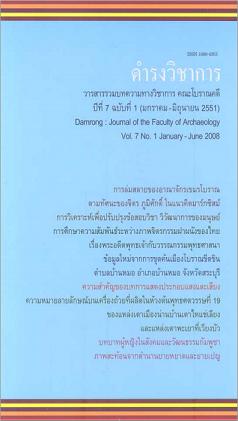A STUDY ON THE RELATIONSHIP BETWEEN THAI MURAL PAINTING ABOUT THE BHUDHAS OF THE PAST AN LITERATURE IN RELATION OF BUDDHISM
Keywords:
จิตรกรรมฝาผนัง, พระพุทธศาสนา, อดีตพุทธAbstract
After the life time of Buddha, Buddhists have believed that reading and copying the scripture is one from making merit. This tradition was spread to many places that received Buddhism from both India and Thailand. Evidence of this appears in sculptures and paintings. Thais have specially liked painting murals about the Buddhas of the past, stories of the previous lives of the Bhuddha , the story of the life of the load Buddha and the Three World Story.
Although literary works and painting appear to be unrelated forms of the fine arts, they have maintained a firm relationship in the Bhuddist tradition though mural painting. Although both literary works and paintings are branches of fine arts, they are different from each other. The source of the story from the murals is the literature. At the same time we can estimate that the inspiration for the mural fundamentally the Thai literary work.
Buddhists believe that the scripture is the Buddha's words because primary evidence was founded in the Tripitaka . Afterwards, the commentary teacher magnified the scripture, reaching various sects of the Buddhism. This was the cause of the variety of the scriptures and the literary works today. Therefore it has influenced the fine arts that have a foundation in the beliefs and respect of Buddhists.
References
กรมการศาสนา. ประวัติศาสตร์พุทธศาสนา, กรุงเทพฯ : กรมการศาสนา, 2527.
กรมศิลปากร, ตํานานมูลศาสนา กรุงเทพมหานคร : โรงพิมพ์พระจันทร์, 2519. (โปรดเกล้าฯ ให้พิมพ์พระราชทานในงานพระราชทานเพลิงศพหม่อมหลวงเดชสนิทวงศ์ ณ เมรุหน้าพลับพลาอิศริยาภรณ์ วัดเทพศิรินทราวาส, 17 ธันวาคม 2518).
กรมศิลปากร,จิตรกรรมและศิลปวัตถุในกรุพระปรางค์วัดราชบูรณะ จังหวัดพระนครศรีอยุธยา พระนคร : ศิวพรการพิมพ์, 2501.
กมลา กองสุข “ภาพมารวิชัยในจิตรกรรมฝาผนังสมัยรัตนโกสินทร์ตอนต้น” วิทยานิพนธ์ ศิลปศาสตรมหาบัณฑิต ภาควิชาโบราณคดี บัณฑิตวิทยาลัย มหาวิทยาลัยศิลปากร, 2534
เจือ สตเวทิน. วรรณคดีพุทธศาสนา, พระนคร : คลังวิทยา, 2506.
บําเพ็ญ ระวิน, รวบรวม. ประชุมพงศาวดารฉบับราษฎร์ ภาค 3 พระอนาคตวงศ์, กรุงเทพฯ : อมรินทร์วิชาการ. 2542.
พระไตรปิฎกภาษาไทย ฉบับหลวง เล่ม 10 พระสุตตันตปิฎก เล่ม 2 ทีฆนิกาย มหาวรรค กรุงเทพฯ : โรงพิมพ์การศาสนา, 2525
พัชรินทร์ ศุขประมูล และคณะ รูปและสัญลักษณ์แห่งพระศากยพุทธ. กรมศิลปากร จัดพิมพ์ประกอบการจัดนิทรรศการพิเศษเนื่องในเทศกาลปุริมเข้าพรรษา ณ พระที่นั่งอิศราวินิจฉัย พิพิธภัณฑสถานแห่งชาติ พระนคร 19 กรกฎาคม - 30 กันยายน 2532.
เสมอชัย พูลสุวรรณ. สัญลักษณ์ในงานจิตรกรรมไทย ระหว่างพุทธศตวรรษที่ 19 ถึง 24. กรุงเทพฯ : มหาวิทยาลัยธรรมศาสตร์, 2539.
รตนปัญญา เถระ ชินกาลมาลีปกรณ์ แปลโดย แสง มนวิทูร.พระนคร : ห้างหุ้นส่วน จํากัด ศิวพร, 2501. กรมศิลปากร จัดพิมพ์เนื่องในการบูรณะโบราณสถาน อําเภอเชียงแสน จังหวัดเชียงราย
ศิลป พระศรี, วิวัฒนาการแห่งจิตรกรรมฝาผนังของไทย. ทรงแปลและเรียบเรียง โดยหม่อมเจ้าสุภัทรดิศ ดิศกุล, พระนคร : ห้างหุ้นส่วนจํากัด ศิวพร, 2502.
เสถียร พันธรังษี, พุทธศาสนามหายาน. กรุงเทพฯ : โรงพิมพ์ประยูรวงศ์, 2512
หลวงบริบาลบุรีภัณฑ์ ปาฐกถาเรื่องพระพุทธศาสนาในประเทศไทย. พิมพ์ครั้งที่ 4 ธนบุรี : โรงพิมพ์การศาสนา, 2514.
เอนก ทอง, รวบรวม. พุทธวงศ์ ประวัติพระพุทธเจ้า 25 พระองค์, กรุงเทพฯ : โรงพิมพ์ การศาสนา, 2541.
Harle, J. C.. The Art and Architecture of the Indian Subcontinent. New Haven and London : Yale University Press, 1994.
Downloads
Issue
Section
License
บทความนี้เป็นผลงานของข้าพเจ้าแต่เพียงผู้เดียว และ/หรือเป็นผลงานของข้าพเจ้าและผู้ร่วมงาน ตามชื่อที่ระบุในบทความจริง และเป็นผลงานที่มิได้ถูกนำเสนอหรือตีพิมพ์ที่ใดมาก่อน




